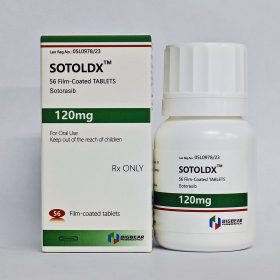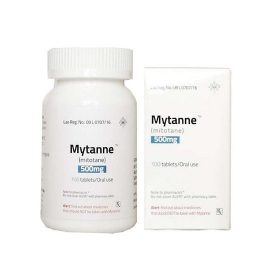- Details
- Description
-
Packaging Size64t/bottle
-
Strength160mg&200mg
-
CompositonCapivasertib
-
TreatmentBreast Cancer with one or more PIK3CA/AKT1/PTEN alterations
-
FormTablet
-
BrandLuciCapiva
-
Quantity Unit160mg*64t/Box&200mg*64t/Box
-
ManufacturerLucius Pharmaceuticals (Lao) Co.,Ltd
About Capivasertib
Capivasertib is an orally bioavailable, small-molecule inhibitor of all three AKT isoforms. Capivasertib used in combination with fulvestrant , is indicated for adults with hormone receptor-positive, human epidermal growth factor receptor 2-negative locally advanced or metastatic breast cancer with one or more PIK3CA/AKT1/PTEN-alterations, following progression on at least one endocrine-based regimen in the metastatic setting or recurrence on or within twelve months of completing adjuvant therapy.
Breast Cancer
Indicated in combination with fulvestrant for hormone receptor (HR)-positive, human epidermal growth factor receptor 2 (HER2)-negative locally advanced or metastatic breast cancer with ≥1 PIK3CA/AKT1/PTEN-alterations, following progression on at least 1 endocrine-based regimen in the metastatic setting; or recurrence during, or within 12 months after completing, adjuvant therapy
Capivasertib weekly dose schedule
- 400 mg PO BID (~12 hr apart) x 4 consecutive days followed by 3 days off
- Repeat weekly schedule until disease progression or unacceptable toxicity
Fulvestrant regimen during clinical trial
- 28-day cycles
- Cycle 1: 500 mg IM on Days 1 and 15
- Subsequent cycles: 500 mg IM on Day 1
- Premenopausal and perimenopausal women: Administer a luteinizing hormone-releasing hormone (LHRH) agonist according to current clinical practice standards
- Men: Consider administering a LHRH agonist according to current clinical practice standards
Dosage Modifications
Dose reductions for adverse reactions
- First dose reduction: 320 mg BID x 4 days followed by 3 days off
- Second dose reduction: 200 mg BID x 4 days followed by 3 days off
Hyperglycemia
- Note that recommendations are based on fasting glucose (FG) rather than random glucose
-
FG >ULN-160 mg/dL (8.9 mmol/L) or hemoglobin A1C (HbA1C) >7%
- Consider initiation or intensification of oral antidiabetic treatment
-
FG 161-250 mg/dL (9-13.9 mmol/L)
- Withhold until FG decrease to ≤160 mg/dL (≤8.9 mmol/L)
- If recovery occurs in ≤28 days, resume at same dose
- If recovery occurs in >28 days, resume at 1 lower dose
-
FG 251-500 mg/dL (14-27.8 mmol/L)
- Withhold until FG decrease to ≤160 mg/dL (≤8.9 mmol/L)
- If recovery occurs in ≤28 days, resume at 1 lower dose
- If recovery occurs in >28 days, permanently discontinue
-
FG >500 mg/dL (>27.8 mmol/L) or life-threatening sequelae of hyperglycemia at any FG level
- Life-threatening sequelae of hyperglycemia or if FG persists at ≥500 mg/dL after 24 hr: Permanently discontinue
- If FG ≤500 mg/dL (or ≤27.8 mmol/L) within 24 hr, follow above guidance for relevant grade
Diarrhea
-
Grade 2
- Withhold until recovery to Grade ≤1
- If recovery occurs in ≤28 days: Resume at same dose or 1 lower dose as clinically indicated
- If recovery occurs in >28 days: Resume at 1 lower dose
- For recurrence: Reduce by 1 lower dose
-
Grade 3
- Withhold until recovery to Grade ≤1
- If recovery occurs in ≤28 days: Resume at same dose or 1 lower dose as clinically indicated
- If recovery occurs in >28 days: Permanently discontinue
-
Grade 4
- Permanently discontinue
Cutaneous reactions
-
Grade 2
- Withhold until recovery to Grade ≤1 then resume at same dose
- Persistent or recurrent: Reduce by 1 lower dose
-
Grade 3
- Withhold until recovery to Grade ≤1
- If recovery occurs in ≤28 days: Resume at same dose
- If recovery occurs in >28 days: Resume at 1 lower dose
- For recurrence: Permanently discontinue
-
Grade 4
- Permanently discontinue
Other adverse reactions
-
Grade 2
- Withhold until recovery to Grade ≤1
- Resume at same dose
-
Grade 3
- Withhold until recovery to Grade ≤1
- If recovery occurs in ≤28 days: Resume at same dose
- If recovery occurs in >28 days: Resume at 1 lower dose
-
Grade 4
- Permanently discontinue
Strong and moderate CYP3A inhibitors
- Strong inhibitor: Avoid coadministration; if unavoidable, reduce dose to 320 mg BID x 4 days followed by 3 days off
- Moderate inhibitor: Reduce dose to 320 mg PO BID x 4 days followed by 3 days off
- After discontinuing strong or moderate CYP3A inhibitor, resume capivasertib dosage (after 3-5 half-lives of CYP3A inhibitor) that was taken before initiating strong or moderate CYP3A inhibitor
Renal impairment
- Mild-to-moderate (CrCl 30-89 mL/min): No dosage adjustment required
- Severe (CrCl 15-29 mL/min): Not studied
Hepatic impairment
- Mild (bilirubin ULN or bilirubin >1-1.5x ULN and any AST): No dosage adjustment required
- Moderate (bilirubin >1.5-3x ULN and any AST): Monitor for adverse reactions due to potential increased capivasertib exposure
- Severe (bilirubin >3x ULN and any AST): Not studied














